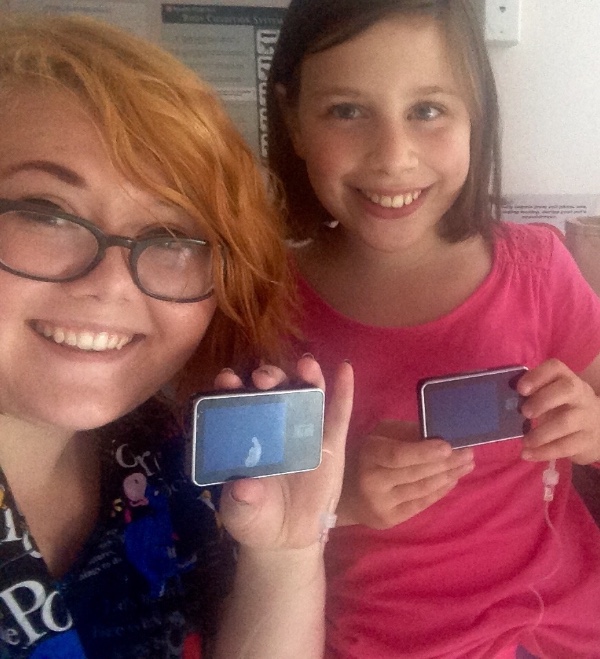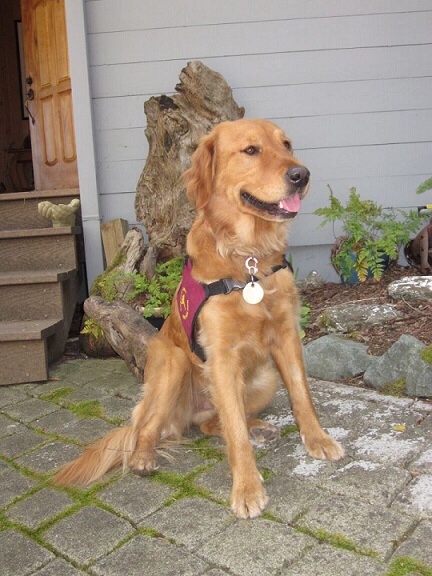
A diabetic alert dog for Serena!
Donation protected
EDIT 7/24/16: Please check our campaign updates for an update and explanation for the reduced campaign goal.
Most people want a dog for companionship, I would like one because it could save my life.
Hello! My name is Serena Carrier. I'm a high school senior, a vet assistant at a local clinic, and a type 1 diabetic for over 6 years. That last part is probably the most important part of my identity, as it affects every single part of my life. From checking my sugar 4-8 times a day, to waking up at 6am with low blood sugar, to staying home from school in order to lower my blood sugar, diabetes and all of its complications is a full time job in its own sense.
Any diabetic can tell you that after a few years we start to lose our ability to sense when our sugar is high or low. I am especially unaware to my high blood sugars, but I often have trouble noticing my low blood sugars until I am incredible low. Low blood sugars can cause sweating, hunger, fatigue, uncontrollable shaking, confusion, heart palpitations, anxiety, blurred vision, nausea, fainting, and even seizures. This becomes especially dangerous at night time, when if my blood sugar drops below 80 mg/dL and if I don't wake up, I could easily die in my sleep. High blood sugar can be just as dangerous, though it is much slower to effect me. High blood sugars can cause sweating, frequent urination, increased thirst, blurred vision, headaches, nausea, vomiting, shortness of breath, confusion, weakness, abdominal pain, and comas. This doesn't even begin to mention the other diseases and problems that result from diabetes (for instance, I have necrobiosis lipoidica diabeticorum and occasional meralgia paresthetica). Having high blood sugar can lead to a multitude of long term problems as well.
Where do dogs come into this?
Good question, potential donator! A diabetic alert dog is a specialized type of service dog. Diabetic alert dogs are trained to alert an owner when they have either high (usually over 200mg/dL) or low (usually under 80mg/dL) blood glucose, usually by putting a paw on the handler. Diabetic alert dogs are wonderful tools in managing blood glucose as they smell the change in blood sugar rather then the current blood sugar. This means that these dogs excell in alerting diabetics up to an hour before it is actually low, enabling diabetics to account for lows before they happen. Diabetic alert dogs have been shown to have incredible results. A study published through Diabetes Care Journal found that DADs were able to alert 20-45 minutes in advance, alert their handlers of hyperglycemia and hypoglycemia at least 91.7% of the time, and decrease A1C levels as much as 1.5% within the first four months of placement (each 1% decrease in a1c leads to a 40% decrease in the long term side effects of diabetes). There is also the emotional support provided by DADs. These dogs are trained to alert their handlers during the night if they go low or high, which could help avoid a huge emergency. They are also trained to retrieve their owners glucometers so that they can check their blood sugars ( I personally have trouble walking when my blood glucose is low) and their low blood sugar snacks so that they can raise their sugar up. They can also be trained to call 911 for help, which is essential to someone who could be alone a lot in her college dorm (aka me in a few months).
Why do I need your money?
Well to be quite honest, diabetic alert dogs are expensive. Incredibly, incredibly expensive. Around $15,000 of expensive for a fully trained dog. Why are they so expensive? Well, first of all, they need to acquire a dog from a reputable breeder who AKC registers their dogs. Next, they have to take care of vaccines, neuter/spays, microchips, and preliminary x-rays to avoid any bone problems later on. After about 6 months, they are placed with a trainer and matched up with a prospective owner. The owner sends samples of their saliva during both low and high blood sugars and the trainer works with these samples to train the dog with their specific scent. The dog will go through over 750 hours of service dog training, receive an obedience training certification, public service certification, a scent recognition certification and an active alert certification. After the trainer decides the dog is ready, they will fly out to my house and both the dog and I will go through 2-3 days of in-house training. If you have any more questions about the training the dogs go through, or the certifications they recieve you can check out this website: Diabetic Alert Dogs of America
EDIT 7/24/16: Please check our campaign updates for an update and explanation for the reduced campaign goal.
We need all the help we can get. If only 250 people donated $10 each we would reach our goal. We also need the help of you to spread the word. The more people we reach, the more people can help!
I would really love it if you considered donating to my cause. Every little bit helps, whether it's $20 or $200. I hope that I have gained your support to help add a new,possibly life saving, member to our family.
 
 
 

Here's some videos of DADs in action:
<iframe media_type="0" media_id="C4I9INnXB2A" class="youtube-replace" title="YouTube video player" style="margin-bottom:20px;width:560px;height:315px;" src="//www.youtube.com/embed/C4I9INnXB2A/?rel=0" frameborder="0" allowfullscreen="1"></iframe>
<iframe media_type="0" media_id="5vZj1JY4e0U" class="youtube-replace" title="YouTube video player" style="margin-bottom:20px;width:560px;height:315px;" src="//www.youtube.com/embed/5vZj1JY4e0U/?rel=0" frameborder="0" allowfullscreen="1"></iframe>
Most people want a dog for companionship, I would like one because it could save my life.
Hello! My name is Serena Carrier. I'm a high school senior, a vet assistant at a local clinic, and a type 1 diabetic for over 6 years. That last part is probably the most important part of my identity, as it affects every single part of my life. From checking my sugar 4-8 times a day, to waking up at 6am with low blood sugar, to staying home from school in order to lower my blood sugar, diabetes and all of its complications is a full time job in its own sense.
Any diabetic can tell you that after a few years we start to lose our ability to sense when our sugar is high or low. I am especially unaware to my high blood sugars, but I often have trouble noticing my low blood sugars until I am incredible low. Low blood sugars can cause sweating, hunger, fatigue, uncontrollable shaking, confusion, heart palpitations, anxiety, blurred vision, nausea, fainting, and even seizures. This becomes especially dangerous at night time, when if my blood sugar drops below 80 mg/dL and if I don't wake up, I could easily die in my sleep. High blood sugar can be just as dangerous, though it is much slower to effect me. High blood sugars can cause sweating, frequent urination, increased thirst, blurred vision, headaches, nausea, vomiting, shortness of breath, confusion, weakness, abdominal pain, and comas. This doesn't even begin to mention the other diseases and problems that result from diabetes (for instance, I have necrobiosis lipoidica diabeticorum and occasional meralgia paresthetica). Having high blood sugar can lead to a multitude of long term problems as well.
Where do dogs come into this?
Good question, potential donator! A diabetic alert dog is a specialized type of service dog. Diabetic alert dogs are trained to alert an owner when they have either high (usually over 200mg/dL) or low (usually under 80mg/dL) blood glucose, usually by putting a paw on the handler. Diabetic alert dogs are wonderful tools in managing blood glucose as they smell the change in blood sugar rather then the current blood sugar. This means that these dogs excell in alerting diabetics up to an hour before it is actually low, enabling diabetics to account for lows before they happen. Diabetic alert dogs have been shown to have incredible results. A study published through Diabetes Care Journal found that DADs were able to alert 20-45 minutes in advance, alert their handlers of hyperglycemia and hypoglycemia at least 91.7% of the time, and decrease A1C levels as much as 1.5% within the first four months of placement (each 1% decrease in a1c leads to a 40% decrease in the long term side effects of diabetes). There is also the emotional support provided by DADs. These dogs are trained to alert their handlers during the night if they go low or high, which could help avoid a huge emergency. They are also trained to retrieve their owners glucometers so that they can check their blood sugars ( I personally have trouble walking when my blood glucose is low) and their low blood sugar snacks so that they can raise their sugar up. They can also be trained to call 911 for help, which is essential to someone who could be alone a lot in her college dorm (aka me in a few months).
Why do I need your money?
Well to be quite honest, diabetic alert dogs are expensive. Incredibly, incredibly expensive. Around $15,000 of expensive for a fully trained dog. Why are they so expensive? Well, first of all, they need to acquire a dog from a reputable breeder who AKC registers their dogs. Next, they have to take care of vaccines, neuter/spays, microchips, and preliminary x-rays to avoid any bone problems later on. After about 6 months, they are placed with a trainer and matched up with a prospective owner. The owner sends samples of their saliva during both low and high blood sugars and the trainer works with these samples to train the dog with their specific scent. The dog will go through over 750 hours of service dog training, receive an obedience training certification, public service certification, a scent recognition certification and an active alert certification. After the trainer decides the dog is ready, they will fly out to my house and both the dog and I will go through 2-3 days of in-house training. If you have any more questions about the training the dogs go through, or the certifications they recieve you can check out this website: Diabetic Alert Dogs of America
EDIT 7/24/16: Please check our campaign updates for an update and explanation for the reduced campaign goal.
We need all the help we can get. If only 250 people donated $10 each we would reach our goal. We also need the help of you to spread the word. The more people we reach, the more people can help!
I would really love it if you considered donating to my cause. Every little bit helps, whether it's $20 or $200. I hope that I have gained your support to help add a new,possibly life saving, member to our family.
 
 
 
Here's some videos of DADs in action:
<iframe media_type="0" media_id="C4I9INnXB2A" class="youtube-replace" title="YouTube video player" style="margin-bottom:20px;width:560px;height:315px;" src="//www.youtube.com/embed/C4I9INnXB2A/?rel=0" frameborder="0" allowfullscreen="1"></iframe>
<iframe media_type="0" media_id="5vZj1JY4e0U" class="youtube-replace" title="YouTube video player" style="margin-bottom:20px;width:560px;height:315px;" src="//www.youtube.com/embed/5vZj1JY4e0U/?rel=0" frameborder="0" allowfullscreen="1"></iframe>
Organizer and beneficiary
Serena Carrier
Organizer
Midland, VA
Jason Carrier
Beneficiary